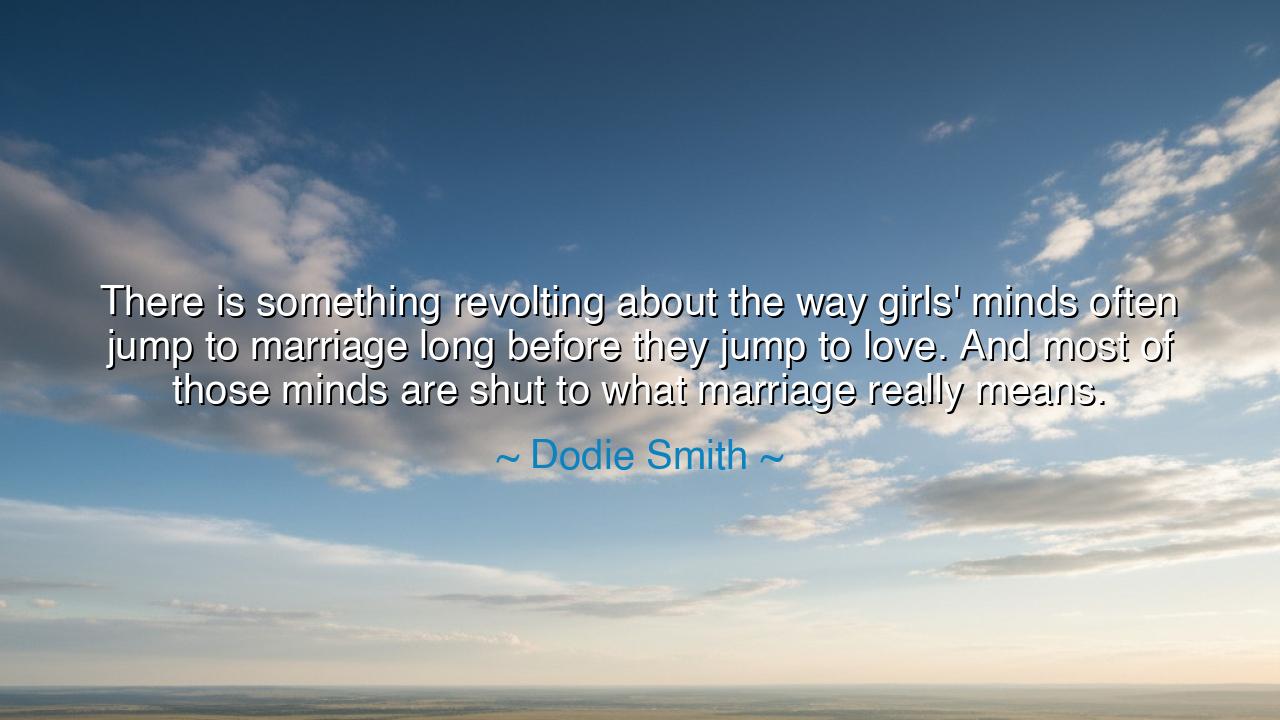
There is something revolting about the way girls' minds often
There is something revolting about the way girls' minds often jump to marriage long before they jump to love. And most of those minds are shut to what marriage really means.






"There is something revolting about the way girls' minds often jump to marriage long before they jump to love. And most of those minds are shut to what marriage really means." These words by Dodie Smith speak with the weight of wisdom, drawing attention to the misconception of marriage as an idealized destination, rather than a deep, complex partnership built on mutual understanding, respect, and love. Smith’s critique of the way young women often view marriage—not as a choice borne out of love, but as an endpoint to a journey—forces us to question how society shapes our understanding of romance and commitment.
In ancient times, the institution of marriage was less about love than it was about societal stability. In Rome, marriage was considered a fundamental bond that ensured the continuity of families and the transmission of wealth and status. Love was not often the central concern; rather, a match was made for the benefit of the family, securing alliances and strengthening social standing. For women especially, marriage was seen as a role to be fulfilled, a means of securing safety and honor, not a pursuit of personal happiness or romantic love. In this sense, Smith’s words touch upon an ancient truth—that for much of human history, the very nature of marriage was misunderstood or narrowly defined.
The true meaning of marriage has evolved significantly over time, especially in the wake of romanticism in the 18th and 19th centuries, when the concept of love became central to the notion of marriage. In these later centuries, women like Jane Austen began to explore the tension between the social contract of marriage and the personal choice of love in novels such as Pride and Prejudice. Austen’s heroines often find themselves torn between marrying for security and marrying for love, highlighting the shift from pragmatic unions to more emotional and personal commitments. Still, even in Austen’s time, many young women were encouraged to marry for reasons beyond love, such as wealth, status, or family obligation. Thus, Smith’s observation—though directed at the modern world—has echoes of these older patterns, where girls are raised with a tendency to envision marriage before they fully understand the true depths of love.
In the 20th century, women’s liberation movements began to question these norms more profoundly, advocating for the right of women to marry for love, but also for the freedom to pursue self-fulfillment outside of marriage. The feminist movement of the 1960s and 70s emphasized that marriage should not be viewed as a goal or necessity, but as a choice—one that should be entered into with awareness, equality, and mutual respect. Yet, even today, many young women find themselves caught in the web of societal expectations, envisioning marriage as an obligatory step rather than a partnership based on love, respect, and equality. Smith’s words critique this vision, pointing out the tragic disconnect between romantic ideals and the reality of what marriage truly demands.
Marriage is a complex union that requires deep commitment, the ability to navigate the hardships of life together, and an understanding of one another’s needs and desires. It is not a fairy tale ending, but a lifelong journey—one that requires patience, sacrifice, and understanding. Think of the story of Elizabeth Barrett Browning and Robert Browning, whose passionate love transcended the boundaries of their time. Despite the pressures of society and her family’s opposition, Barrett Browning defied the conventional expectations of marriage, choosing love as her guiding force. Their relationship was one of mutual respect, built on shared intellectual passions and unwavering commitment to one another. This is the true essence of marriage—not a formal step toward fulfillment, but a deep connection between two individuals, evolving and growing over time.
The lesson from Dodie Smith’s reflection is one of awareness and reflection. Marriage is not to be pursued as a mere formality, nor is it to be seen as an obligation placed upon women by society. It must be entered into with understanding and a clear grasp of what it requires. Before seeking marriage, one must first seek self-love, self-understanding, and the ability to offer genuine, thoughtful love to another. Women, in particular, must reject the notion that marriage is a goal to be reached before love is fully realized. Instead, we must see marriage as a choice to be made after an honest assessment of what it truly means—to us, and to the person we choose to walk alongside.
To young women, I say: take the time to understand love before the idea of marriage takes hold of your mind. Seek deep, meaningful relationships with yourselves, so that when the time comes, you can enter into marriage not out of necessity or societal pressure, but from a place of mutual respect, understanding, and love. Marriage is not a formality to be fulfilled; it is a journey of commitment, joy, and challenge, one that should be chosen consciously and lived with integrity. The true meaning of marriage lies not in the ceremony, but in the love, respect, and commitment shared between two individuals willing to grow together, side by side, in mutual understanding.






AAdministratorAdministrator
Welcome, honored guests. Please leave a comment, we will respond soon